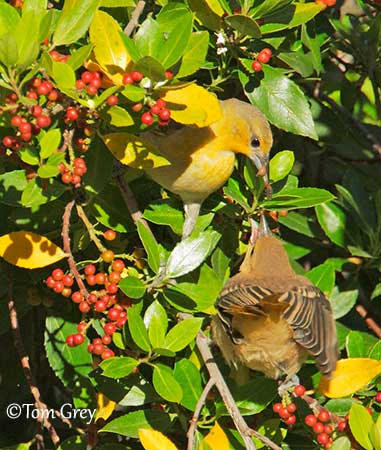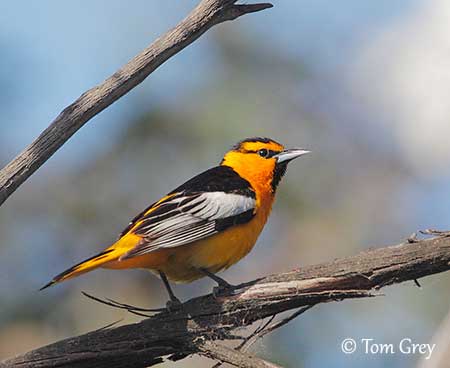
PROTECTION / THREATS / STATUS:
The Bullock’s Oriole is described as common or fairly common throughout most of the range. It may occur in modified habitats.
It is considered as beneficial to agriculture because it takes Black scale (Saissetia oleae) which is a pest of citrus and olive plantations.
The global population is estimated to number 3,800,000 individuals, and is suspected to be stable.
The Bullock’s Oriole is currently evaluated as Least Concern.
Fr: Oriole de Bullock
Ang: Bullock's Oriole
All: Bullocktrupial
Esp: Turpial de Bullock
Ita: Oriolo di Bullock
Nd: Bullocks Troepiaal
Sd: bullocktrupial
Photographer:
Tom Grey
Tom Grey's Bird Pictures & Tom Grey's Bird Pictures 2
Text by Nicole Bouglouan
Sources:
HANDBOOK OF THE BIRDS OF THE WORLD Vol 16 by Josep del Hoyo- Andrew Elliot-David Christie – Lynx Edicions – ISBN: 9788496553781
NEW WORLD BLACKBIRDS – THE ICTERIDS by Alvaro Jaramillo and Peter Burke – Helm - ISBN : 0713643331
A GUIDE TO THE BIRDS OF MEXICO AND NORTHERN CENTRAL AMERICA by Steve N. G. Howell, Sophie Webb - Oxford University Press - ISBN: 0198540124
FIELD GUIDE TO THE BIRDS OF NORTH AMERICA by National Geographic Society - National Geographic Society - ISBN: 0792274512
All About Birds (Cornell Lab of Ornithology)
The Birds of North America online
Bird Web (Seattle Audubon Society)
Wikipedia, the free encyclopaedia
What Bird-The ultimate Bird Guide (Mitchell Waite)
Bullock’s Oriole
Icterus bullockii
Passeriformes Order – Icteridae Family
INTRODUCTION:
The Bullock’s Oriole is a member of the family Icteridae. It was formerly treated as conspecific with the Baltimore Oriole (I. galbula) and both were considered to be the same species named Northern Oriole.
The Bullock’s Oriole is sexually dimorphic, with brightly coloured males and much duller and paler females. It frequents habitats edges, open woods and riverside groves, and breeds in fairly open habitats with deciduous trees. This species nests in a hanging pouch attached to a branch of tall deciduous tree. It feeds on insects, berries, various fruits and nectar.
The name of this species pays tribute to the English naturalist William Bullock.
The Bullock’s Oriole is not globally threatened and the population is suspected to be currently stable.
DESCRIPTION OF THE BIRD:
Biometrics:
Length: 19-23 cm
Weight: 37-38 g
The Bullock’s Oriole adult male in breeding plumage has black crown, nape and back. Lower back, uppertail-coverts and underparts are yellow-orange, except for a narrow black stripe from chin to upper breast.
The upperwing is black but median and greater coverts are white, forming a conspicuous wingbar. The black flight-feathers show broad, white edges. The tail is black, but the outer rectrices are yellow-orange with black tips.

The non-breeding male has head and back feathers narrowly tipped greyish and the underpart’s feathers have whitish tips. The white edges of the wing feathers are broader.
The pointed bill is bluish-grey with black culmen. The eyes are dark brown. Lores are black and we can see a black eyeline extending to the ear-coverts. Legs and feet are bluish-grey.
The adult female is much duller, with pale orange-yellow face, supercilium, throat and breast. The underparts are whitish-grey. Back and wings are greyer and paler, and the conspicuous white wingbar is absent, but we can see two faint white wingbars. The tail is orange-olivaceous. Some females may have a black throat stripe.

The juvenile resembles female but it has duller and reduced yellow on face and throat. The wingbars are less extensive and the upperparts may be washed saffron to buff. It obtains the adult plumage through intermediate stages.
RANGE:
The Bullock’s Oriole breeds from S British Columbia, S Alberta and SW Saskatchewan in Canada, S into Texas and into Mexico, W through N Durango, Sonora and into N Baja California. The coastal regions are the western limits of the range.
This species winters mainly in Mexico S to W Guatemala where it is rare. There are some records on the Pacific slopes of Costa Rica and El Salvador.
HABITAT:
The Bullock’s Oriole breeds mainly in deciduous forest or forest patches, and favours open woodlands and woodland edges. It is mainly found in riparian corridors through desert, grasslands or other types of unforested areas.
It forages in open areas and can be seen in urban areas and parks during the breeding season. Outside this period, it often forages in urbanizations and can be seen on cultivated flowering bushes and on hummingbird’s feeders.
It winters in various habitats, from thorn forests and pine oak woodlands to humid tropical forests.
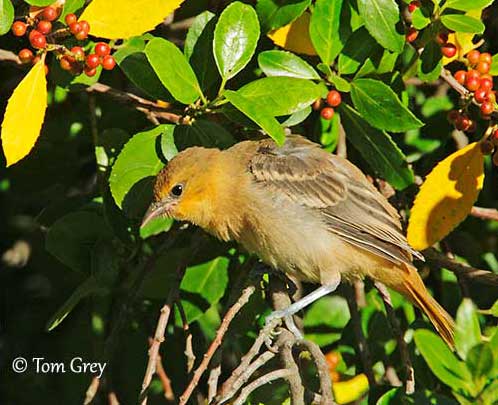
CALLS AND SONGS: SOUNDS BY XENO-CANTO
The Bullock’s Oriole gives a short rattle “chu-r-r-r-r-r”, also a single, sweet note “pheew” and a soft “chuch”.
The musical song is a clear and flute-like sound, ending in a sweet whistled note “kip, kit-tick, kit-tick,whew,wheet”. The female also sings, especially early in the season and during nest-building.
BEHAVIOUR IN THE WILD:
The Bullock’s Oriole feeds on insects, berries and nectar. The diet in summer includes mainly caterpillars and insects such as beetles, grasshoppers, crickets, wasps, bugs and also spiders. Berries, wild and cultivated fruits are taken too, as well as nectar and sugar-water at hummingbird’s feeders.
It forages mainly among tree foliage and rarely on the ground. Insects can be caught in the air while flying.
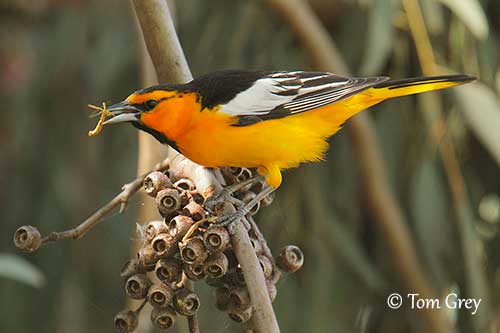
The Bullock’s Oriole male defends the territory by singing. This species is mostly monogamous, with pair-bonds for only one breeding season. During the courtship displays, the male is in front of the female. It stretches upright while the tail is fanned. The wings are partly open and quivering. They nest solitary or in loose colonies of 15-18 nests/ha.
The Bullock’s Oriole is migratory and leaves the breeding areas in July-August and the arrival in S (Mexico) is mainly in September/October.
They return in late winter and reach the southern part of the breeding range from mid-March, whereas it reaches the northern part in May and until June. The females return usually 1-2 weeks later than males.
The Bullock’s Oriole has swift, direct flight with rapid wingbeats.
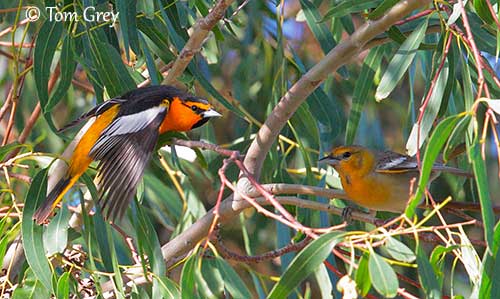
Male and female
Courtship displays
REPRODUCTION OF THIS SPECIES:
The breeding season takes place in April-June, but earlier in the south of the breeding range.
The Bullock’s Oriole nests in a tall deciduous tree such as willow, cottonwood and other hardwood trees. The female builds a hanging pouch, with the rim attached to a branch, between 3 and 8 metres above the ground, not far from water. She is sometimes helped by her mate.
The nest is made with woven plant fibres, strips of bark, vine tendrils, grass and sometimes string. It is lined inside with softer grass, plant down and hair.
The female lays 4-5 pale bluish or pale grey eggs with dark markings on the larger end. She incubates alone during 12-14 days. The chicks are fed by both parents and mainly on insects. They fledge two weeks after hatching and often remain on family groups. They may join other families in post-breeding flocks.
This species produces a single brood per season.
